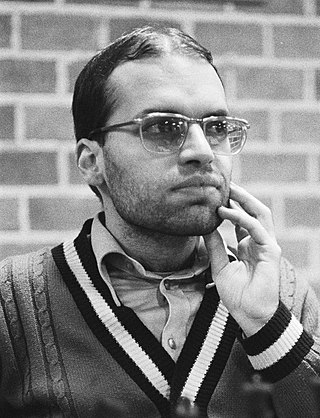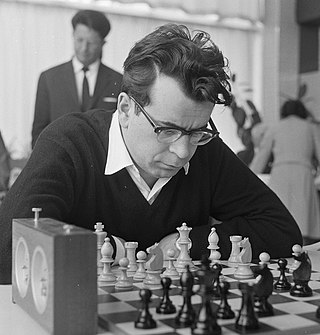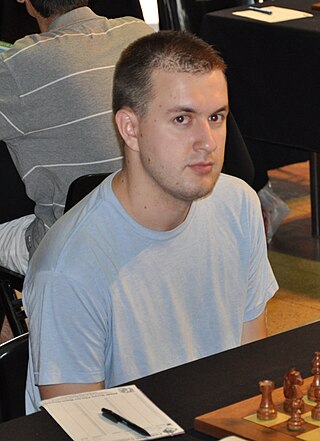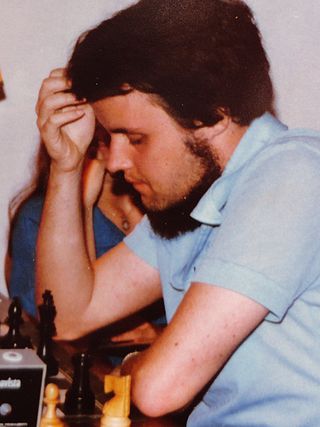
Jan Timman is a Dutch chess grandmaster who was one of the world's leading chess players from the late 1970s to the early 1990s. At the peak of his career, he was considered to be the best non-Soviet player and was known as "The Best of the West". He has won the Dutch Chess Championship nine times and has been a Candidate for the World Chess Championship several times. He lost the title match of the 1993 FIDE World Championship against Anatoly Karpov.

Yasser Seirawan is a Syrian-born American chess grandmaster and four-time United States champion. He won the World Junior Chess Championship in 1979. Seirawan is also a published chess author and commentator.

Leonid Zakharovych Stein was a Soviet chess Grandmaster from Ukraine. He won three USSR Chess Championships in the 1960s, and was among the world's top ten players during that era.

Jørgen Bent Larsen was a Danish chess grandmaster and author. Known for his imaginative and unorthodox style of play, he was the second-strongest non-Soviet player, behind only Bobby Fischer, for much of the 1960s and 1970s. He is considered to be the strongest player born in Denmark and the strongest from Scandinavia until the emergence of Magnus Carlsen.
The Modern Defense is a hypermodern chess opening in which Black allows White to occupy the center with pawns on d4 and e4, then proceeds to attack and undermine this "ideal" center without attempting to occupy it.

Henrique Costa Mecking, also known as Mequinho, is a Brazilian chess grandmaster who reached his zenith in the 1970s and is still one of the strongest players in Brazil. He was a chess prodigy, drawing comparisons to Bobby Fischer, although he did not achieve the International Grandmaster title until 1972. He won the Interzonals of Petropolis 1973 and Manila 1976. His highest FIDE rating is 2635, achieved in 1977, when he was ranked number four in the world. He became the third-best player in the world in 1977, behind only World Champion Anatoly Karpov and Viktor Korchnoi.

Robert Eugene Byrne was an American chess player and chess author who held the FIDE title of Grandmaster (GM). He won the U.S. Championship in 1972, and was a World Chess Championship Candidate in 1974. Byrne represented the United States nine times in Chess Olympiads from 1952 to 1976 and won seven medals. He was the chess columnist from 1972 to 2006 for The New York Times, which ran his final column on November 12, 2006. Byrne worked as a university professor for many years, before becoming a chess professional in the early 1970s.

Lajos Portisch is a Hungarian chess Grandmaster, whose positional style earned him the nickname, the "Hungarian Botvinnik". One of the strongest non-Soviet players from the early 1960s into the late 1980s, he participated in twelve consecutive Interzonals from 1962 through 1993, qualifying for the World Chess Championship Candidates Cycle a total of eight times. Portisch set several all-time records in Chess Olympiads. In Hungarian Chess Championships, he either shared the title or won it outright a total of eight times. He won many strong international tournaments during his career. In 2004, Portisch was awarded the title of 'Nemzet Sportolója', Hungary's highest national sports achievement award.

Pal Charles Benko was a Hungarian and American chess player, author, and composer of endgame studies and chess problems.

Mark Bluvshtein is a Soviet-born Canadian chess player. He became the youngest Canadian ever to achieve the title of Grandmaster in 2004, at the age of 16. He previously achieved the title International Master at the age of 13.

Kevin Spraggett is a Canadian chess grandmaster. He was the first Canadian-born player and fourth Canadian overall to earn the grandmaster title, after Abe Yanofsky, Duncan Suttles and Peter Biyiasas.
Zvonko Vranesic is a Croatian–Canadian International Master of chess, and an International Master of Correspondence Chess. He is an electrical engineer, a university professor, and a developer of computer chess software.
Lawrence Alexander Day is a Canadian chess player, author, and journalist who holds the FIDE title of International Master. He represented Canada at 13 Chess Olympiads.

Peter Biyiasas is a Canadian chess grandmaster. He was Canadian champion in 1972 and 1975, represented Canada with success on four Olympiad teams, and played in two Interzonals. He moved to the United States in 1979, settling in California. He retired from competitive play in the mid-1980s to work as a computer programmer. During the late 1970s and early 1980s, he was a frequent training partner of Bobby Fischer, who stayed at his home in San Francisco for extended periods.
Deen Hergott is a Canadian International Master of Chess. By profession, he is a mathematician, computer programmer, and chess journalist.
Pascal Charbonneau is a Canadian chess grandmaster. He has won two Canadian Chess Championships, in 2002 and 2004, and has represented Canada in five Chess Olympiads: 2000, 2002, 2004, 2006 and 2008.

Jean Hébert is a Canadian chess player, writer, journalist, and commentator who holds the ICCF title of Correspondence Chess Grandmaster and the FIDE title of International Master. The winner of the Canadian Chess Championship in 1978 and 2009, he also tied for the title in 2007, but lost in playoffs. He represented Canada at the 1979 Interzonal tournament as well as seven times at Chess Olympiads. He also took part in the Chess World Cup 2009, but was knocked out by Peter Svidler in the first round. In 2022, Hébert won the Canadian Seniors' Championship.

Alexander Mikhailovich Chernin is a Soviet-born Hungarian chess grandmaster and trainer.

Igor Vasilyevich Ivanov was a Russian-born chess grandmaster who defected from the Soviet Union to Canada in 1980. A four-time winner of the Canadian chess championship, he represented Canada at an interzonal tournament for the world chess championship and was a Canadian team member at two Chess Olympiads. He also was a nine-time US Grand Prix chess champion.
Elod Macskasy was a Hungarian-Canadian chess master.













